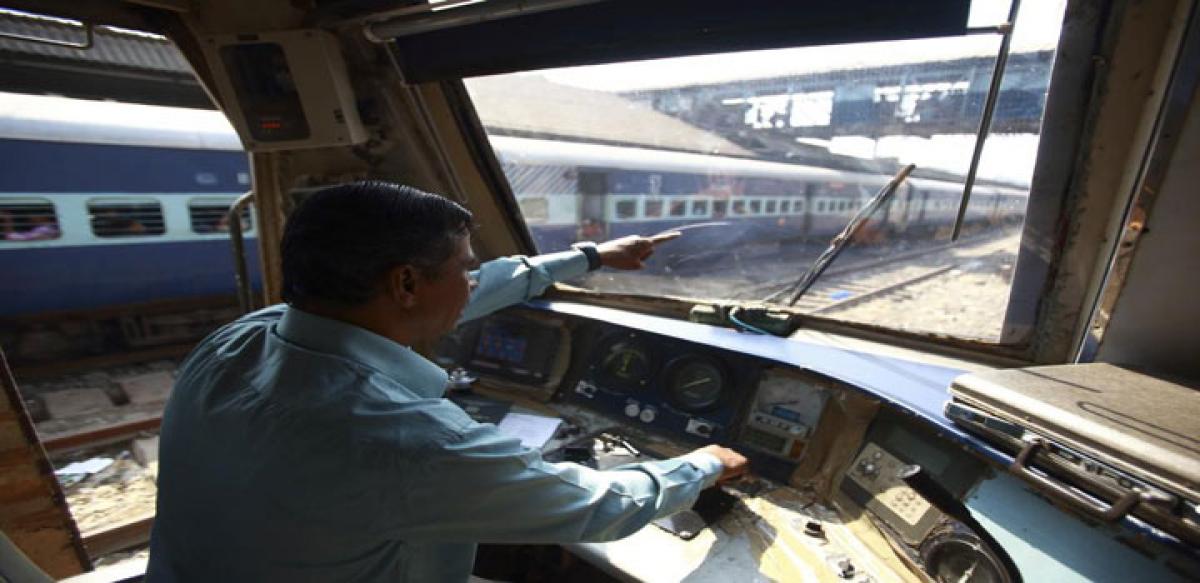Live
- Ananya Panday’s Career Glow-Up: From Criticism to Impactful Storytelling
- Gurugram Festival to celebrate India’s artistic spirit and legacy this November
- SCMHRD, Pune clinches Winner’s Trophy at Cummins India’s REDEFINE 2024 B-School Case Study Competition
- HerKey Concludes Powerful AccelHERate 2024 in Hyderabad, Continues Momentum in Advancing Workplace Diversity
- Alpenliebe Juzt Jelly Introduces India’s First Dual-Layer Jelly In A Heart-Shape
- Vi Scales-up Users’ Indoor Network Experience in 20+ Districts of Andhra Pradesh and Telangana
- Meet Kannada Actor Tarak Ponnappa, Who Steals the Show in Pushpa 2: The Rule
- Union Minister Rajnath Singh to Attend Bhakti TV’s Koti Deepotsavam in Hyderabad
- MakeMyTrip Will Acquire CRED's Happay Expense Management Platform to Improve its Business Travel Services
- TTD Board Makes Path-Breaking Decisions
Just In

If the train in which you travelled arrives safely, thank your stars for an overworked loco pilot could have easily dozed off leading to an accident. Luckily though, the 12,000-odd loco pilots in South Central Railway (SCR) have been punching above their weight and working against all odds.
Existing loco pilots are working against all odds but for how long is a question that the Railways isn’t looking into
Secunderabad: If the train in which you travelled arrives safely, thank your stars for an overworked loco pilot could have easily dozed off leading to an accident. Luckily though, the 12,000-odd loco pilots in South Central Railway (SCR) have been punching above their weight and working against all odds.
“We really do not know how but we are doing the job day in and day out, said a weary looking loco pilot at the dharna organised by the South Central Railway Mazdoor Union (SCRMU) at Rail Nilayam here on Tuesday.
As per the Hours of Employment and Regulation (HOER) rules from the moment of signing in and signing off, a loco pilot has to work for 10 hours, be out of headquarters for not more than 72 hours and has to put in 104 hours of work every fortnight. “Ironically, technology up gradation has brought in more stress.
Our demand is to reduce the continuous working hours from 8 to 6 and return to headquarters in 36 hours,” says P Ravinder, assistant divisional secretary, SCRMU, Secunderabad. On an average 12 loco pilots are removed from service every year in SCR for a major blunder like Signal Passing at Danger (SPAD). If a loco pilot passes a signal even by a few metres he is removed from service.
A loco pilot on condition of anonymity asks, “It is fair to have strict rules but is it not the duty of the Indian Railways to provide enough rest. Ninety nine per cent of SPADs happen due to deprivation of sleep. Once a pilot works for 8 hours he has to be given 16 hours rest but citing lack of staff we are called on duty even before we recoup from the last journey.”
A loco pilot has to keep a watch on signals every single minute as a signal whizzes past him every minute. Apart from keeping a watch on signals, a loco pilot has to keep pressing the Vigilance Control Device (VCD) every 60 seconds failing which the train comes to a halt automatically after 72 seconds).
The moment a pilot takes charge of the loco he is busy and does not have time to even have food or attend to nature’s call. There is no provision of water closets in locomotives. The Indian Railway Loco Running Men’s Organisation (IRLRO) approached the National Human Rights Commission (NHRC) on the issue after the Railway Board informed that the demand of drivers cannot be fulfilled. As per HOER rules, a loco pilot has to be given 30-hour rest after every six days, but this rarely happens.
Suresh (name changed on request), a loco pilot says, “I have not been with my family for either Dusshera or Diwali in the last six years as there are so many special trains pressed into service. Getting leave is becoming difficult with each passing year.”
While the rules mandate that Leave Reserve (LR) is to be maintained at a 30 per cent ratio, which means- If there is a requirement of 100 loco pilots at any given point of time, 130 pilots have to be available but hardly 10 per cent is maintained.
A senior loco pilot says, “The overhead 25 KV electric equipment emits induction and the residual heat inside the loco makes it very hot. During summer, especially in Ramagundam and Kothagudem 3-4 pilots get sun stroke every day as the temperature can go up to 60 degrees in cabin.”
The WAM-4 loco still does not have good seating for drivers. Just due to the working conditions, every year about 50 loco pilots are declared unfit. Spondylitis (sitting in one position continuously for 8 hours by keeping a watch on signals), diabetes, hypertension and heart problems are common among them.

© 2024 Hyderabad Media House Limited/The Hans India. All rights reserved. Powered by hocalwire.com







